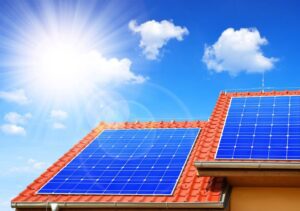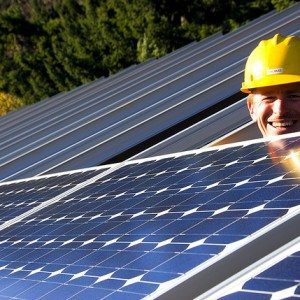 Reducing monthly bills is one of the most important things on a homeowner’s to-do list. Instead of paying for electricity from a local power company every month, a homeowner can have solar panels installed to provide electricity to their home. These solar panels will absorb energy from the sun and convert it into electricity that can be used to power everything in a home, including the hot water heater. Who wants to continue paying for electricity when they can generate their own with solar panels? There are many benefits to installing a solar power system on your property.
Reducing monthly bills is one of the most important things on a homeowner’s to-do list. Instead of paying for electricity from a local power company every month, a homeowner can have solar panels installed to provide electricity to their home. These solar panels will absorb energy from the sun and convert it into electricity that can be used to power everything in a home, including the hot water heater. Who wants to continue paying for electricity when they can generate their own with solar panels? There are many benefits to installing a solar power system on your property.
- Home
- Residential
- Commercial
- Tesla
- Testimonials
- About Us
- Contact Us
Category: Solar Panels
 Reducing monthly bills is one of the most important things on a homeowner’s to-do list. Instead of paying for electricity from a local power company every month, a homeowner can have solar panels installed to provide electricity to their home. These solar panels will absorb energy from the sun and convert it into electricity that can be used to power everything in a home, including the hot water heater. Who wants to continue paying for electricity when they can generate their own with solar panels? There are many benefits to installing a solar power system on your property.
Reducing monthly bills is one of the most important things on a homeowner’s to-do list. Instead of paying for electricity from a local power company every month, a homeowner can have solar panels installed to provide electricity to their home. These solar panels will absorb energy from the sun and convert it into electricity that can be used to power everything in a home, including the hot water heater. Who wants to continue paying for electricity when they can generate their own with solar panels? There are many benefits to installing a solar power system on your property.
Going Green With Solar Panels
Written by goldensolar on . Posted in Green Living, Solar Panels, Solar Power. Leave a Comment
 This recent trend toward environmental-friendliness doesn’t look to be an isolated one. It’s been near the forefront since 2013, and in 2015 there it will remain. We will see an even greater emphasis on eco-friendly building material. Among all of these fun green trends, however, the one that stands head and shoulders above the rest though is solar panels.
Solar power systems have been growing in popularity since they were first introduced, and in 2015, plan to see their popularity continue to grow. These photovoltaic solar cells appear just as a standard roof shingle would but also provide that added eco-friendly edge that standard roof shingles lack. In this way, solar panels are able to blend in such as homeowners might prefer; after all, the name of the game for many homeowners’ associations is uniformity. While managing to appear main stream, this solar technology, however, is anything but. Instead of following the crowd, these solar panel systems are the stars of the roofing industry. Why, you ask? Well, in addition to providing energy efficiency, these panels actually capture the sun’s energy using monocrystalline silicon solar cells.
Captured solar power can be harnessed by individual panels such that, when grouped in a solar panel system, they can provide electric power for the entire house. Do you see why they’re the stars of the green movement? They not only benefit the individual consumer’s bottom line but also reduce his carbon footprint, this latter result being a benefit both locally and globally. Here at Golden Solar, we applaud the growing popularity of solar power systems, and at the same time, we invite individuals not currently operating on solar power to consider making this change away from the old standard to the rising star.
After all, solar panels, for all of their other virtues, are also an investment that pays for itself. Indeed, each and every state in the Union offers the Federal Solar Tax Credit, a blend of rebates, incentives, and subsidies that will make the move to solar power highly attractive. So, with solar power systems, you are going green and doing so in a financially beneficial way. What’s not to like?
This recent trend toward environmental-friendliness doesn’t look to be an isolated one. It’s been near the forefront since 2013, and in 2015 there it will remain. We will see an even greater emphasis on eco-friendly building material. Among all of these fun green trends, however, the one that stands head and shoulders above the rest though is solar panels.
Solar power systems have been growing in popularity since they were first introduced, and in 2015, plan to see their popularity continue to grow. These photovoltaic solar cells appear just as a standard roof shingle would but also provide that added eco-friendly edge that standard roof shingles lack. In this way, solar panels are able to blend in such as homeowners might prefer; after all, the name of the game for many homeowners’ associations is uniformity. While managing to appear main stream, this solar technology, however, is anything but. Instead of following the crowd, these solar panel systems are the stars of the roofing industry. Why, you ask? Well, in addition to providing energy efficiency, these panels actually capture the sun’s energy using monocrystalline silicon solar cells.
Captured solar power can be harnessed by individual panels such that, when grouped in a solar panel system, they can provide electric power for the entire house. Do you see why they’re the stars of the green movement? They not only benefit the individual consumer’s bottom line but also reduce his carbon footprint, this latter result being a benefit both locally and globally. Here at Golden Solar, we applaud the growing popularity of solar power systems, and at the same time, we invite individuals not currently operating on solar power to consider making this change away from the old standard to the rising star.
After all, solar panels, for all of their other virtues, are also an investment that pays for itself. Indeed, each and every state in the Union offers the Federal Solar Tax Credit, a blend of rebates, incentives, and subsidies that will make the move to solar power highly attractive. So, with solar power systems, you are going green and doing so in a financially beneficial way. What’s not to like?How the Polluting Companies’ Dollar Give Solar Panels for the Poor
Written by goldensolar on . Posted in Solar Panels, Solar Power. Leave a Comment
 Recently the Californian government set the stage for affordable solar energy to low-income residents. About $14.7 million has been raised from the Golden State’s cap and the trade system to move the project of installing solar panels to underprivileged neighborhoods for free forward . This program aims to lessen the energy costs for families that could be of great help, as it also lessens the environmental footprints.
This approach limits the amount of greenhouse gases a company can emit on a regular basis, and it reprimands polluting companies, such as power plants and oil refineries to purchase credit for each ton consumed. This credit can be used to help families save a good amount of cash over the year.
The group is also planning to install the paneling for more than 1,600 families before the end of next year. These families will be able to save money every month for clothes, food, medical expenses, and so on. To support that, one of locals who can enjoy this kind of privilege is Roy Rivera. He lives with a disability and relies on a fixed income, that it’s almost impossible to make ends meet. However, because of this project, he’ll be able to save as much as $818 one energy costs during the first year of installation, and he can use that money to buy his other essentials.
Even though the use of solar energy can help in cutting down the family’s costs, the installation price can be quite expensive– it can cost $15,000 or more, and this is the main reason why a lot of low-income Americans aren’t capable of using their energy source. The price of installation alone restricts them. This was based on the findings made by the San Francisco Chronicle.
Based on the data gathered last year, there are more or less 3.5% of all rooftop solar installations across three different states, namely: Massachusetts, Maryland, and New York. The median household incomes fall below $39,999.
Though, there are more than 54% of installations in Maryland where the household income exceeds $90,000. This only implies one thing: people are interested in trying this source of energy if they’re capable with, and can pay it.
Thus, the California program is trying to alleviate this kind of financial burden to those residents who barely earn a living. If granted, this can be a win-win situation for both the company and residents as well.
Just like what the Vice’s Brian Merchant mentioned, being able to control the population business, that will allow the families to take advantage of that can be the best strategy for all.
This program also has the opportunity of increasing the ‘good optics,’ because everyone wants to have a cleaner environment, but the cost and expense of it are just some of the usual restrictions that make it impossible.
Recently the Californian government set the stage for affordable solar energy to low-income residents. About $14.7 million has been raised from the Golden State’s cap and the trade system to move the project of installing solar panels to underprivileged neighborhoods for free forward . This program aims to lessen the energy costs for families that could be of great help, as it also lessens the environmental footprints.
This approach limits the amount of greenhouse gases a company can emit on a regular basis, and it reprimands polluting companies, such as power plants and oil refineries to purchase credit for each ton consumed. This credit can be used to help families save a good amount of cash over the year.
The group is also planning to install the paneling for more than 1,600 families before the end of next year. These families will be able to save money every month for clothes, food, medical expenses, and so on. To support that, one of locals who can enjoy this kind of privilege is Roy Rivera. He lives with a disability and relies on a fixed income, that it’s almost impossible to make ends meet. However, because of this project, he’ll be able to save as much as $818 one energy costs during the first year of installation, and he can use that money to buy his other essentials.
Even though the use of solar energy can help in cutting down the family’s costs, the installation price can be quite expensive– it can cost $15,000 or more, and this is the main reason why a lot of low-income Americans aren’t capable of using their energy source. The price of installation alone restricts them. This was based on the findings made by the San Francisco Chronicle.
Based on the data gathered last year, there are more or less 3.5% of all rooftop solar installations across three different states, namely: Massachusetts, Maryland, and New York. The median household incomes fall below $39,999.
Though, there are more than 54% of installations in Maryland where the household income exceeds $90,000. This only implies one thing: people are interested in trying this source of energy if they’re capable with, and can pay it.
Thus, the California program is trying to alleviate this kind of financial burden to those residents who barely earn a living. If granted, this can be a win-win situation for both the company and residents as well.
Just like what the Vice’s Brian Merchant mentioned, being able to control the population business, that will allow the families to take advantage of that can be the best strategy for all.
This program also has the opportunity of increasing the ‘good optics,’ because everyone wants to have a cleaner environment, but the cost and expense of it are just some of the usual restrictions that make it impossible.Why You Should Choose Solar Panels For Your Home
Written by goldensolar on . Posted in Solar Panels, Solar Power. Leave a Comment
Typically, most residential consumers use power grids for their electricity. So when there is a huge power shortage or outage many people are affected. Not to mention there is much concern that we are rapidly depleting our energy sources. So what does the future hold?
 Many people theorize that the next wave of energy production must come from renewable energy sources. Such as solar power. Solar power is a viable commercial energy source and is a constant; as opposed to the other renewable energy sources like wind, biomass, biofuel and geothermal power. Which is why many people are making the investment in installing solar panels. There are a large number of reasons why people should consider installing solar panels. For the sake of brevity, and sticking to the most important ones, here is a list of the top five reasons why you should get solar panels installed on your home.
1. Economics. The first reason you should add solar panels to your home is that they will save you money. Solar panels produce energy for your home, which means they allow you to take less energy from the utility company. After you have made the initial investment to install solar panels, your monthly utility bill will decrease drastically. Over the course of 5, 10, or 20 years, you will save thousands upon thousands of dollars, because your home will be producing the energy that it uses.
2. Community. Solar panel installation is also good for the community you live in. Everyone in your community relies on the utility company in your area for energy. However, those utility companies can increase the rates as they like, and people have to pay it. Having solar panels decreases the amount of energy that your home takes from the utility company, and can even put energy back into the grid. This helps to decrease the demand for energy in your community and works to stabilize energy rates for your neighbors.
3. Environment. One of the most obvious benefits of solar panels is that they are better for the environment. Rather than depending on coal burning power plants to provide electricity, which dirties the air and leads to all sorts of environmental problems, solar panels harness the clean energy of the sun. They make the world cleaner and better for future generations.
4. Infrastructure. The fourth reason solar panels are great is that they increase the infrastructure in the country. If everyone depends on the utility company, and that company has an issue one day, everyone loses their power. Utility companies are susceptible to this sort of thing. Having solar panels decreases your reliance on the utility company, benefiting the overall infrastructure of the country.
5. Security. Along the same lines as the infrastructure argument, having solar panels on your home creates more energy security for your home. You are no longer dependent on anyone else for your energy. This means that even if the grid goes down, or the utility company runs out of coal to burn, you will have power in your home.
A great solar panel company in Colorado is Golden Solar. They understand all of the benefits solar has to offer to communities and individuals, and want to help you go solar as soon as possible.
Many people theorize that the next wave of energy production must come from renewable energy sources. Such as solar power. Solar power is a viable commercial energy source and is a constant; as opposed to the other renewable energy sources like wind, biomass, biofuel and geothermal power. Which is why many people are making the investment in installing solar panels. There are a large number of reasons why people should consider installing solar panels. For the sake of brevity, and sticking to the most important ones, here is a list of the top five reasons why you should get solar panels installed on your home.
1. Economics. The first reason you should add solar panels to your home is that they will save you money. Solar panels produce energy for your home, which means they allow you to take less energy from the utility company. After you have made the initial investment to install solar panels, your monthly utility bill will decrease drastically. Over the course of 5, 10, or 20 years, you will save thousands upon thousands of dollars, because your home will be producing the energy that it uses.
2. Community. Solar panel installation is also good for the community you live in. Everyone in your community relies on the utility company in your area for energy. However, those utility companies can increase the rates as they like, and people have to pay it. Having solar panels decreases the amount of energy that your home takes from the utility company, and can even put energy back into the grid. This helps to decrease the demand for energy in your community and works to stabilize energy rates for your neighbors.
3. Environment. One of the most obvious benefits of solar panels is that they are better for the environment. Rather than depending on coal burning power plants to provide electricity, which dirties the air and leads to all sorts of environmental problems, solar panels harness the clean energy of the sun. They make the world cleaner and better for future generations.
4. Infrastructure. The fourth reason solar panels are great is that they increase the infrastructure in the country. If everyone depends on the utility company, and that company has an issue one day, everyone loses their power. Utility companies are susceptible to this sort of thing. Having solar panels decreases your reliance on the utility company, benefiting the overall infrastructure of the country.
5. Security. Along the same lines as the infrastructure argument, having solar panels on your home creates more energy security for your home. You are no longer dependent on anyone else for your energy. This means that even if the grid goes down, or the utility company runs out of coal to burn, you will have power in your home.
A great solar panel company in Colorado is Golden Solar. They understand all of the benefits solar has to offer to communities and individuals, and want to help you go solar as soon as possible.
 Many people theorize that the next wave of energy production must come from renewable energy sources. Such as solar power. Solar power is a viable commercial energy source and is a constant; as opposed to the other renewable energy sources like wind, biomass, biofuel and geothermal power. Which is why many people are making the investment in installing solar panels. There are a large number of reasons why people should consider installing solar panels. For the sake of brevity, and sticking to the most important ones, here is a list of the top five reasons why you should get solar panels installed on your home.
1. Economics. The first reason you should add solar panels to your home is that they will save you money. Solar panels produce energy for your home, which means they allow you to take less energy from the utility company. After you have made the initial investment to install solar panels, your monthly utility bill will decrease drastically. Over the course of 5, 10, or 20 years, you will save thousands upon thousands of dollars, because your home will be producing the energy that it uses.
2. Community. Solar panel installation is also good for the community you live in. Everyone in your community relies on the utility company in your area for energy. However, those utility companies can increase the rates as they like, and people have to pay it. Having solar panels decreases the amount of energy that your home takes from the utility company, and can even put energy back into the grid. This helps to decrease the demand for energy in your community and works to stabilize energy rates for your neighbors.
3. Environment. One of the most obvious benefits of solar panels is that they are better for the environment. Rather than depending on coal burning power plants to provide electricity, which dirties the air and leads to all sorts of environmental problems, solar panels harness the clean energy of the sun. They make the world cleaner and better for future generations.
4. Infrastructure. The fourth reason solar panels are great is that they increase the infrastructure in the country. If everyone depends on the utility company, and that company has an issue one day, everyone loses their power. Utility companies are susceptible to this sort of thing. Having solar panels decreases your reliance on the utility company, benefiting the overall infrastructure of the country.
5. Security. Along the same lines as the infrastructure argument, having solar panels on your home creates more energy security for your home. You are no longer dependent on anyone else for your energy. This means that even if the grid goes down, or the utility company runs out of coal to burn, you will have power in your home.
A great solar panel company in Colorado is Golden Solar. They understand all of the benefits solar has to offer to communities and individuals, and want to help you go solar as soon as possible.
Many people theorize that the next wave of energy production must come from renewable energy sources. Such as solar power. Solar power is a viable commercial energy source and is a constant; as opposed to the other renewable energy sources like wind, biomass, biofuel and geothermal power. Which is why many people are making the investment in installing solar panels. There are a large number of reasons why people should consider installing solar panels. For the sake of brevity, and sticking to the most important ones, here is a list of the top five reasons why you should get solar panels installed on your home.
1. Economics. The first reason you should add solar panels to your home is that they will save you money. Solar panels produce energy for your home, which means they allow you to take less energy from the utility company. After you have made the initial investment to install solar panels, your monthly utility bill will decrease drastically. Over the course of 5, 10, or 20 years, you will save thousands upon thousands of dollars, because your home will be producing the energy that it uses.
2. Community. Solar panel installation is also good for the community you live in. Everyone in your community relies on the utility company in your area for energy. However, those utility companies can increase the rates as they like, and people have to pay it. Having solar panels decreases the amount of energy that your home takes from the utility company, and can even put energy back into the grid. This helps to decrease the demand for energy in your community and works to stabilize energy rates for your neighbors.
3. Environment. One of the most obvious benefits of solar panels is that they are better for the environment. Rather than depending on coal burning power plants to provide electricity, which dirties the air and leads to all sorts of environmental problems, solar panels harness the clean energy of the sun. They make the world cleaner and better for future generations.
4. Infrastructure. The fourth reason solar panels are great is that they increase the infrastructure in the country. If everyone depends on the utility company, and that company has an issue one day, everyone loses their power. Utility companies are susceptible to this sort of thing. Having solar panels decreases your reliance on the utility company, benefiting the overall infrastructure of the country.
5. Security. Along the same lines as the infrastructure argument, having solar panels on your home creates more energy security for your home. You are no longer dependent on anyone else for your energy. This means that even if the grid goes down, or the utility company runs out of coal to burn, you will have power in your home.
A great solar panel company in Colorado is Golden Solar. They understand all of the benefits solar has to offer to communities and individuals, and want to help you go solar as soon as possible.What Are The Most Common Types Of Solar Panels
Written by goldensolar on . Posted in Solar Panels, Solar Power. Leave a Comment
 Solar energy is quickly becoming one of the most talked about forms of renewable energy. The benefits of installing solar panels is quite evident and there are many consumers looking to make the switch. But where to begin? How do you know what kind of solar panels work best for your property? To answer these questions, you must first educate yourself on the different types of solar panels are on the market today. Everyone who intends to install solar panels to generate electricity should know the main types of panels available. This knowledge will make panel selection easier and faster. Here is a brief description of the three major types of solar panels on the market.
Solar energy is quickly becoming one of the most talked about forms of renewable energy. The benefits of installing solar panels is quite evident and there are many consumers looking to make the switch. But where to begin? How do you know what kind of solar panels work best for your property? To answer these questions, you must first educate yourself on the different types of solar panels are on the market today. Everyone who intends to install solar panels to generate electricity should know the main types of panels available. This knowledge will make panel selection easier and faster. Here is a brief description of the three major types of solar panels on the market.
-
Mono crystalline
-
Polycrystalline
-
Thin-film










